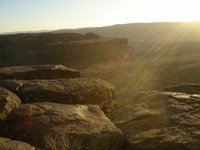

“…the Escalante country belongs to us. It lies entirely within the public domain, and is therefore the property not of land and cattle companies, not of oil and mining corporations, not of the Utah State Highway Department or any Utah Chamber of Commerce, but of all Americans. It’s our country. Or should be. It’s suppose to be. Edward Abbey, 1971.
About 80 percent of Utah is public land. A state that is mostly run by the BLM, forest service, national park, etc. Although each agency has different intentions, one thing holds true – these are OUR lands. Lands to explore, to escape to, to gain a sense of place, to lose yourself or to find yourself. America has places set aside where no development, logging or mining can exist. Places where roads aren’t paved and where trees are left to rot on the ground – only to grow new life again. Places where water flows free without dams, except made by beavers. Where the night sky isn’t interrupted by light pollution and when you look up into the vastness of space the stars are so dense finding the big dipper is challenging. Places where the sense of time escapes you, letting you to wonder free. FREE! A feeling so powerful it is hard to describe because to be free means something different for everyone. Have you really ever felt freedom – a life or a moment without distractions? I strive for this freedom everyday.

The Grand Staircase Escalante National Monument is one of the wildest places in America – just barely escaping the claws of developers. It encompasses 1.7 million acres of land across southern Utah. This land is so diverse and grand you would need multiple lifetimes to explore it. I spent a week and a half here. Escalante is the type of place where one mile feels like ten and where canyons turn into cathedrals. It’s an intimate place with a power streaming through every grain of sand. This area has a history so intense you actually feel the struggles and triumphs of people’s past. When you’re hiking across the rugged country you feel how the cowboy felt when leading a herd of cattle, but when gathering water from the willow shaded streams you feel native. The history of the Escalante is seen on the canyon walls through petroglyphs and pictographs - stories portraying great hunts of big horn sheep, symbols and human figures that only the original artist knows the full details. Secrets hide in every canyon. The adventures I did where some of the best I have ever experienced. But the thing about this place is that every footprint made in the sand here will disappear when the wind comes, wiping away your presence so the next traveler can discover the secrets this place has to reveal to them – this is Escalante.

































